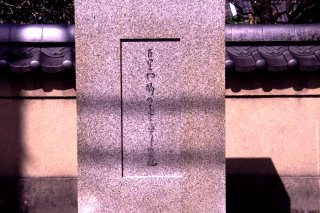::::::::::::::::::::::::::::::::::::::::::::::::::::::::::::::::::::::::::::::::::::::::::::::::::::::::::::::::::::::::::::::::::::::::::::::::::::::::::::::::::::::::::::::::::::::::::::::::::::::::::::::
- furusato ふるさと 故郷、古里 home village, home town, Heimat -
The mention of the word FURUSATO in Japan will bring a lot of emotions to the heart, it is very very dear to the Japanese!
The German HEIMAT seems a bit similar in emotional potential.
There are many clichees with the Japanese "hometown" feeling, for example the red dragonfly, the graves of the ancestors, the Autumn festival at the local shrine and the food flavor of home (furusato no aji), expecially the miso soup made by mother (o-fukuro no aji).
hometown, home village, my native place, furusato
..... ふるさと 故郷、古里 故里 郷土 郷里
"my old village", "my home village", "my native village"
place where I was born, umare kokyoo 生まれ故郷
home country, kyookoku 郷国、郷関
The Japanese word KOKYOO sounds rather stiff, whereas FURUSATO is pleasing to the ear. Therefore FURUSATO is used mostly in haiku. Ever since Basho used it in his famous haiku, it has been used again and again. Some haiku may sound sentimental just because the use of this word. Yet, since we all can resonate with the feeling of belonging there, most haiku are well liked.
. WKD - furusato 故郷、古里 home town, Heimat.
::::::::::::::::::::::::::::::::::::::::::::::::::::::::::::::::::::::::::::::::::::::::::::::::::::::::::::::::::::::::::::::::::::::::::::::::::::::::::::::::::::::::::::::::::::::::::::::::::::::::::::::
旧里や臍の緒に泣くとしの暮
ふるさとや ほぞのおになく としのくれ
furusato ya hozo no o ni naku toshi no kure
town where I was born -
as I weep over my umbilical cord
the year comes to a close
Tr. Ueda
Written in 1687 貞享4年, Oi no Kobumi
This hokku has the cut marker YA at the end of line 1.
Japanese mothers keep the umbilical cord as a memento of the birth of their babies.
heso no o, hozo no o 臍の緒 umbilical cord
When Basho has the chance to hold it in his hands again in Iga Ueno, he is overwhelmed with the memories of his late mother and father.

Photo: ©(牛久市森田武さん撮影)
Haiku Stone Monument in Iga Ueno
http://www.ese.yamanashi.ac.jp/~itoyo/basho/oinokobumi/oino13.htm#ku3
my home town -
I weep over my navel string
at the end of the year
Tr. Gabi Greve

umbilical cord box へその緒寿箱
The box is called Kotobuki-bako 寿箱 "Long Life Box", and sold at many shrines in Japan. There are many variations, with a small baby doll clad in kimono above the navel string.
....................................................................................................................................................
一里はみな花守の子孫かや
. hitozato wa mina hanamori no shison kana .
hito sato wa mina hanamori no shison ka ya
In this village everyone is a descendant from Cherry Blossom Wardens.
....................................................................................................................................................
鐘撞かぬ里は何をか春の暮
. kane tsukanu sato wa nani o ka haru no kure .
temple bell in the village
(in another version, 'sato' is replaced by 'mura'.)
a village where no
bells ring: what, then,
of spring evenings?
Tr. Barnhill
....................................................................................................................................................
刈りかけし田面の鶴や里の秋
. karikakeshi tazura no tsuru ya sato no aki .
autumn in the village
....................................................................................................................................................
里人は稻に歌詠む都かな
. (satobito) sato-bito wa ine ni uta yomu miyako kana .
the local people from the village
..........................................................................
里古りて柿の木持たぬ家もなし
sato furite kaki no ki motanu ie mo nashi
this old village -
no house without
persimmon trees
Dried kaki fruit was sometimes the only food the poor farmers in the Edo period could eat in winter, since they had to give away all their rice to the authorities for tax purposes. Therefore the kaki trees around each farm house were pure necessity to feed the hungry children.
Written on day 7 of the 8th lunar month in 1694, 元禄7年8月7日 Basho age 51.
Basho stayed at the home of 望翠 Bosui in Iga Ueno.
Some say he was the husband of his sister.
. Katano Boosui 片野望翠 Katano Bosui / 井筒屋新蔵 .
. WKD : kaki 柿 persimmon fruit .
In an old hamlet,
There is not a single house without
A persimmon tree.
Tr. Oseko

source : kikyou0123
..........................................................................
里の子よ梅折り残せ牛の鞭
. sato no ko yo ume orinokose ushi no muchi .
village kids, children of the village
....................................................................................................................................................
山里は万歳遅し梅の花
. yamazato wa manzai ososhi ume no hana .
a mountain village and the New Year's dancers
::::::::::::::::::::::::::::::::::::::::::::::::::::::::::::::::::::::::::::::::::::::::::::::::::::::::::::::::::::::::::::::::::::::::::::::::::::::::::::::::::::::::::::::::::::::::::::::::::::::::::::

With links to many Furusato-Basho towns and events:
source : bashomichi.com/
::::::::::::::::::::::::::::::::::::::::::::::::::::::::::::::::::::::::::::::::::::::::::::::::::::::::::::::::::::::::::::::::::::::::::::::::::::::::::::::::::::::::::::::::::::::::::::::::::::::::::::
. WKD - furusato 故郷、古里 home town, Heimat.
. Cultural Keywords used by Basho .
. - KIGO used by Matsuo Basho 松尾芭蕉 - .
[ . BACK to DARUMA MUSEUM TOP . ]
[ . BACK to WORLDKIGO . TOP . ]
::::::::::::::::::::::::::::::::::::::::::::::::::::::::::::::::::::::::::::::::::::::::::::::::::::::::::::::::::::::::::::::::::::::::::::::::::::::::::::::::::::::::::::::::::::::::::::::::::::::::::::